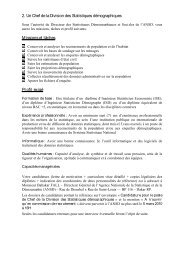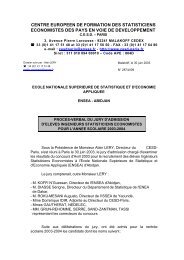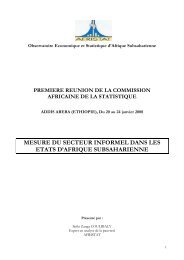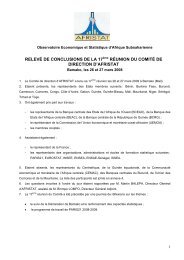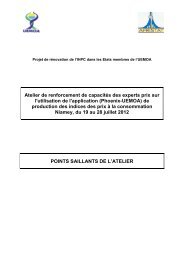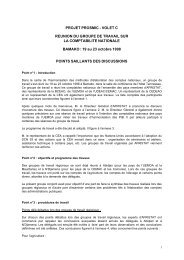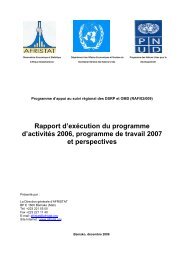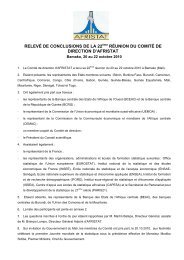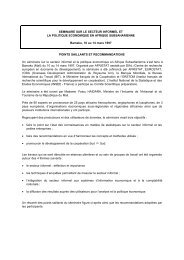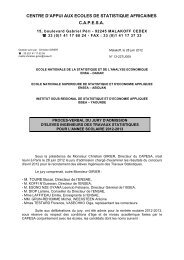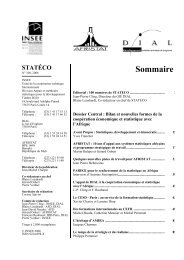Global Purchasing Power Parities and Real Expenditures - Afristat
Global Purchasing Power Parities and Real Expenditures - Afristat
Global Purchasing Power Parities and Real Expenditures - Afristat
You also want an ePaper? Increase the reach of your titles
YUMPU automatically turns print PDFs into web optimized ePapers that Google loves.
156 <strong>Global</strong> <strong>Purchasing</strong> <strong>Power</strong> <strong>Parities</strong> <strong>and</strong> <strong>Real</strong> <strong>Expenditures</strong>Annual National Average PricesIn principle, the annual national average price for 2005 foran individual product should be its average unit value for2005 (that is, the value of the product sold during 2005divided by the quantity sold in 2005). In practice, suchdetailed data are rarely (if ever) available; therefore, the ICPused an approach similar to that used by national statisticaloffices in producing price indexes to deflate the nationalaccounts to obtain volume estimates.Prices were collected throughout 2005 for the productsspecified in each region of the ICP. Typically, the priceswere obtained from a range of different outlets in a sampleof cities <strong>and</strong> towns throughout each economy at least onceevery quarter. Africa collected prices on a monthly basis,while Asia-Pacific, Latin America, <strong>and</strong> Western Asia collectedprices on a quarterly basis. National average priceswere calculated using as weights the quantities sold in differentquarters of the year <strong>and</strong> in different regions of theeconomy. When data on quantities sold were not available,alternatively, regions used expenditures or population asweights. In cases where weights were not available altogether,the annual national average price was calculated asa simple arithmetic mean of the prices observed during theyear, provided that there were no significant seasonal variationsin the prices.Once the national annual average prices were computed,aggregation methods, such as CPD <strong>and</strong> EKS, wereapplied to derive the PPPs at the basic-heading level. (Anoutline of these methods follows. Full details, includingexamples, are presented in chapter 11 of the ICP 2003–2006 H<strong>and</strong>book.)Calculating PPPs atthe Basic-Heading LevelThe following sections provide an overview of the methodsused to compute PPPs at the basic-heading level. The ICPregions used the CPD method; the Eurostat-OECD-CISregions used the EKS* (see below for explanation of differencebetween EKS <strong>and</strong> EKS* methods) methodology.The CPD MethodThe country-product-dummy (CPD) method is a multilateralapproach in which the PPPs are estimated simultaneouslyfor all products <strong>and</strong> for all countries within a region,with simultaneous estimation of prices for all products.A very important property of the PPPs generated by thismodel is that they are transitive.In the 2005 ICP, the starting point of the CPD approachwas a matrix of prices (in national currencies) for productspriced within each country in the region concerned. Therewere gaps in the matrix because it was not possible (<strong>and</strong>neither necessary nor generally desirable) for all countries toprice every product in the list. The CPD method is a regressiontechnique. The underlying model is multiplicative (butadditive in logarithms). It assumes that prices vary by productwithin countries at the same rate across all countries,<strong>and</strong> that prices vary between countries at the same rateacross all products. In practice, one country has to be chosenas a base, <strong>and</strong> all other product/country combinationsare measured in terms of their variation from this base. Anerror term (also multiplicative in this case) is required toh<strong>and</strong>le differences in the observed country/product pricesfrom those generated by the model.The multiplicative CPD model can be illustrated by ageneral example. Let us assume that there are m countries<strong>and</strong> that their product list contains n products. Then, foreach product in each country, the observed price is p ijfor i= 1, 2, . . . , m <strong>and</strong> for j = 1, 2, . . . , n. Note that the pricespij are expressed in each country’s national currencies. Themultiplicative CPD model is expressed in equation (1) asp ij= a ib ju ij, (1)where u ijis the error term.The CPD model is converted from a multiplicative oneto an additive one by expressing the terms in the model aslogarithms in equation (2):log(p ij) = log(a ib ju ij) = log(a i) + log(b j) + log(u ij) (2)



